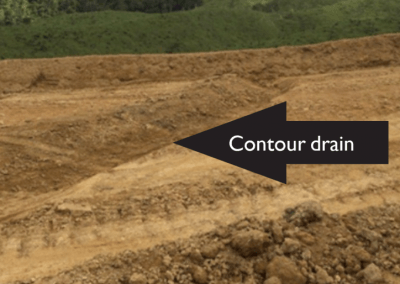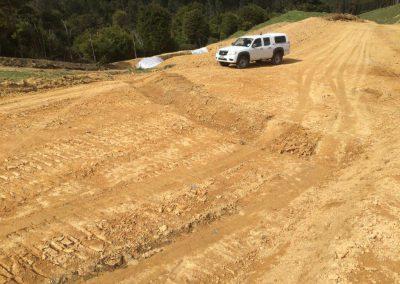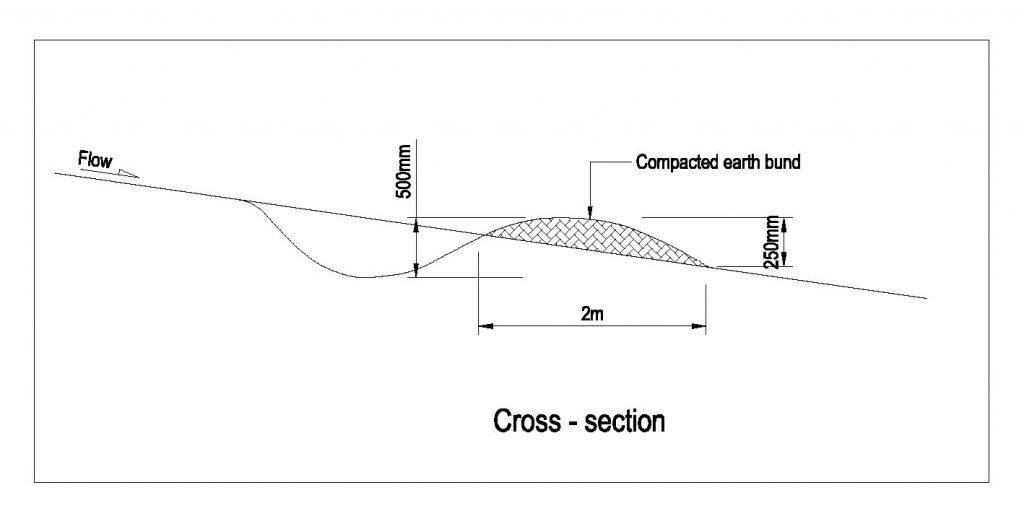Erosion Control
Water management controls
Contour drains
What, Why, When and issues to look out for
What
Contour drains or cut-offs are temporary excavated channels or ridges, or a combination of both, that are constructed across the contour of an area of land that has been disturbed by earthworks.
Although commonly called contour drains, this term is misleading as the drains need to be constructed slightly off the contour to make sure that they drain appropriately.
-

Contour drain (Source: SouthernSkies).
-

Contour drain installed across access track (Source: SouthernSkies).
Why
A contour drain breaks overland flow that is draining down disturbed slopes. It does this by reducing the slope length and thereby reducing the velocity and erosive power of the runoff. The drain also diverts sediment-laden water to appropriate controls via stable outlets.
When
Contour drains should be used on all earthworks sites, especially when there are large areas of exposed ground and long steep slopes.
Contour drains are temporary in nature. They are mainly used in the following situations:
- Installed at the end of the day or when rain is forecast, and removed while earthworks are being done.
- To reduce the overall slope length of a contributing catchment by breaking up the work area into smaller, more manageable zones so that the water velocities on these slopes are reduced. Use them at mid to lower slopes on all exposed areas.
- To help divert dirty water flows towards sediment retention devices (eg a sediment retention pond or decanting earth bund). (Note: Contour drains are different from dirty water diversions because they are temporary and are not sized for a specific rain event).
- To act as cut-offs on tracking activities to direct water into a stable watertable and/or outfall structure. (Watertable refers to the level below which the ground is saturated with water).
Issues to look out for
Contour drains have the following limitations:
- They concentrate sheet flows, which increases the potential for erosion – especially on steep slopes and in any vulnerable soils, such as uncompacted fills and weak soils. So, contour drains must discharge to a suitable diversion channel.
- They may not work well on very steep slopes (>30%) unless they are very closely spaced to achieve performance characteristics.
- Unless the right sizing and spacing of drains is used, they can overtop during high intensity rainfall.
- Longitudinal contour drains with >2% grades will increase flow velocities and may promote erosion. Therefore, steeper contour drains need to be lined to prevent scouring within the channel invert.
- If the contour drain grades are excessively flat, sediment is likely to deposit, which reduces capacity and might mean that the structure overtops.
- Because of their temporary nature, they may be a ‘weak link’ in the ESC Plan if they are installed too late or not sized/spaced appropriately.
Design essential
Because contour drains are temporary, formal design is not usually needed. However, you still must meet the following design essentials for the tool to work:
- Minimum compacted bank height of 250 millimetres.
- Minimum total depth of 500 millimetres.
- Longitudinal gradients not to exceed 2% (otherwise lining may be required).
- Broad enough to create a low-profile bank so that large earthworking machinery can safely cross. (If this is not achievable, you can use a dedicated crossing using a removable culvert).
- Parabolic or square shape profile preferred to avoid potential erosion typically associated with ‘V’ profiles.
- Must discharge to a diversion channel.
- Outlets may need to be lined with geotextile or other suitable material to prevent erosion.
- No individual drain should have more than 0.5 ha draining into it.
-
For indicative maximum catchment slope lengths, see Table 4:
Contour drain spacing
Slope of site Spacing (m) of contour drains Less than 5% 50 5–10% 40 10–15% 30 15–30% 20 - Specifications for contour drains:
Construction and operation
When constructing and operating contour drains
- Construct temporary contour drains across unprotected slopes within the working area at the end of each day, before site closedown or when rain is imminent.
- Carefully consider the spacing and set out, because these are essential factors for the drains to succeed. Start from an erosion proof outlet and work back.
- Where possible, break the work area up using a series of more or less evenly spaced blocks using the slope length and spacing guide in Table 4:
| Slope of site | Spacing (m) of contour drains |
|---|---|
| Less than 5% | 50 |
| 5–10% | 40 |
| 10–15% | 30 |
| 15–30% | 20 |
- Keep the invert gradient around 2% and make the drain as short as possible.
- Avoid V-shaped drains created by a grader or bulldozer, as these can cause erosion within the channel, and sediment. Tyre roll the completed drain to limit this.
- Use an excavator to construct a parabolic drain.
- Compact all earth windrows and banks by tracking with construction plant.
Maintenance and decommissioning
When maintaining contour drains
- Repair or reinstate them if they are damaged by machinery movement.
- Inspect contour drains during rainfall or storms and repair as necessary.
- Check the outfall for erosion and repair if required. You may need to install a temporary flume or provide geotextile.
When decommissioning contour drains
There is no formal decommissioning process for contour drains. Earthworks will simply recommence after the rainfall event.
